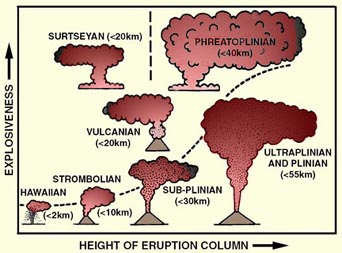
This section describes the variability of eruption types, from quiescent lava emissions to extremely violent, explosive events. Eruption variability is largely related to magma composition and the amount of water present. The various eruption types are typically associated with particular volcano types. Shield volcanoes, for example, generate low-viscosity basalts associated with calm, effusive eruptions. It is common to find traditional names from classic eruptions to describe other eruptions and volcano forms: Hawaiian, Strombolian, Vulcanian, Surtseyan and Vesuvian (Plinian), for example. Although these names are somewhat poorly defined and subjectively applied, they are widely used in the volcanological literature.
 Height of Eruption Column and Degree
of Explosivity -- Whereas
the height of the eruption column can be measured directly in
observed eruptions, it can also be estimated in ancient eruptions
by measuring the geographic dispersal of the airfall tephra.
The degree to which this tephra is fragmented provides a means
to measure the explosiveness of the eruption. The diagram here
(modified from Cas and Wright,
1988) demonstrates how these parameters will vary with
eruption type. For more detailed information on these parameters,
click on image.
Note that hydrovolcanic eruptions
(above dashed line) are generally the most explosive, but do
not necessarily generate the highest eruption columns. Height of Eruption Column and Degree
of Explosivity -- Whereas
the height of the eruption column can be measured directly in
observed eruptions, it can also be estimated in ancient eruptions
by measuring the geographic dispersal of the airfall tephra.
The degree to which this tephra is fragmented provides a means
to measure the explosiveness of the eruption. The diagram here
(modified from Cas and Wright,
1988) demonstrates how these parameters will vary with
eruption type. For more detailed information on these parameters,
click on image.
Note that hydrovolcanic eruptions
(above dashed line) are generally the most explosive, but do
not necessarily generate the highest eruption columns. |
The various types of eruptions described in this section can be simulated with an extraordinary computer program developed by Dr. Ken Wohletz. For a free download of this program, double click Erupt 2.5.
For an explanation on the overall
mechanism of eruption, see Eruption
Model.
For a QuickTime animation of a Plinian-type eruption
see movie.